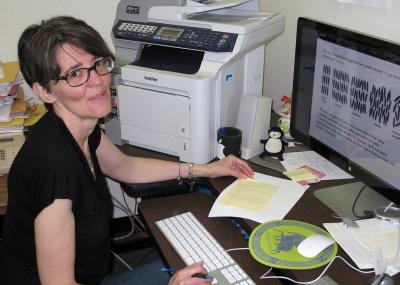NMSU mathematics professor's work may help enhance LCDs

"LCD devices are by and large based on nematic mesophases," said Tiziana Giorgi, full professor of mathematics in the College of Arts and Sciences. "Tilted chiral smectic mesophases, due to their ferroelectric or antiferroelectric properties, are promising since they have superior operational speed and resolution."
Giorgi, who teaches partial differential equations, is studying liquid crystals from a mathematical point of view using models created by chemists and physicists. Her work has been made possible by a three-year, $158,640 grant from the National Science Foundation. Awarded in 2011, Giorgi's is the only NSF grant for applied mathematics held at a New Mexico institution.
"I look at the equations that are involved in the description and study the property of the solutions of these equations," Giorgi said. "The goal is that by looking at the property of the solutions you try to validate these models to see if the solutions contain the property that the liquid crystal has."
There are several types of liquid crystals. Giorgi mainly works with smectic liquid crystals. She is currently working on a model for bent-core molecule liquid crystals introduced by a group of scientists in Slovenia and studying their mathematical properties.
"The energy minimization process is described with partial differential equations, which can then be investigated with computational software and mathematical theories, which is what I do," Giorgi said.
Giorgi has applied sophisticated techniques to find asymptotic behaviors of the model.
"These models are sort of complicated from a mathematical point of view, because you know that the vectors are correlated with each other and that imposes a lot of limitations," Giorgi said. "And so we are trying to see if we can simplify the bent-core model to obtain something that is much more manageable. It makes the mathematics much easier."
As principal investigator, she has used the NSF award to hire graduate students and travel to and from conferences. Working on the project with her are NMSU graduate student Feras Yousef and co-collaborator Robert Smits, professor of mathematics at NMSU.
"I try to interact with physicists from outside the university as much as I can," Giorgi said. "So, what I try to do is go to conferences where I can interact with the world's leaders in the modeling of liquid crystals."
In April, Giorgi spent two months at the Isaac Newton Institute for Mathematical Sciences in Cambridge, U.K., which is holding a six-month program on the mathematics of liquid crystals.
"That was really exciting, because I met some of the people who have developed the ideas of the models that I've been working on in this project," Giorgi said. "So, it gave me the occasion to ask questions about particular forms of energy and models."
Giorgi said it's more than likely she will ask for an extension to the grant, because of the large amount of work that remains.
"When you have some of these liquid crystals, these molecules, under certain conditions they sort of tilt and form an angle with the perpendicular direction," Giorgi said. "When that happens the layer of the liquid crystal shrinks, and that is not good for the displays. So they are very interested in the materials in the so-called de Vries liquid crystal where the shrinking of the layers is very small."
"One thing we are going to do next is look at liquid crystals that have this particular behavior," Giorgi said. "There are theories that model their behaviors, but there are also alternative theories, which are not well established yet."
Giorgi, originally from Rome, joined NMSU in 2002. She teaches both graduate and undergraduate courses including calculus, partial differential equations and numerical analysis. She was recently selected by NMSU to receive a University Research Council Distinguished Career Award for Exceptional Achievements in Creative Scholarly Activities, and will be honored along with other recipients during the university's fall convocation on Aug. 20.
University Research Council Distinguished Career Awards are presented to NMSU faculty and staff who have more than six years at NMSU in recognition of exceptional research and/or other creative scholarly efforts.


